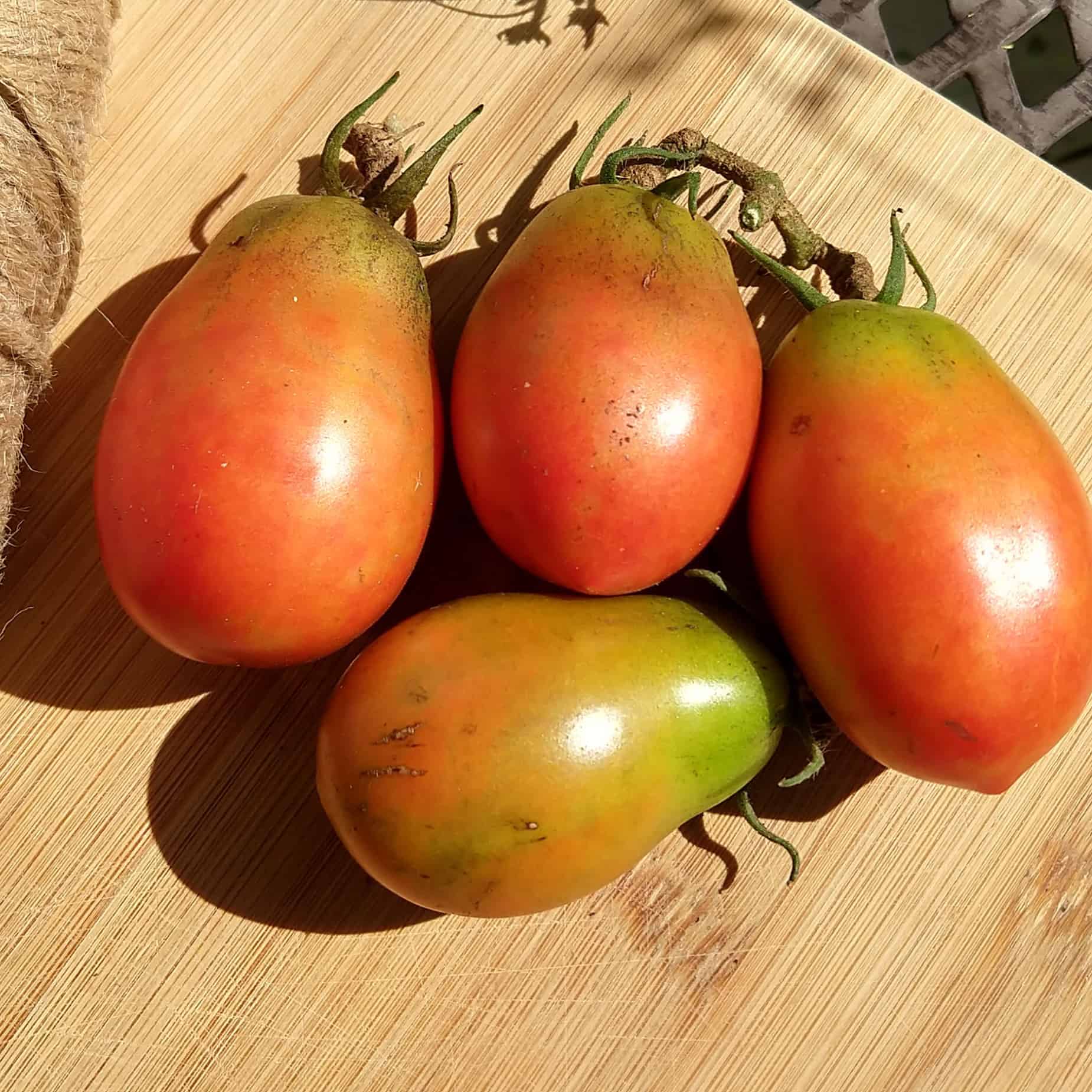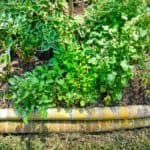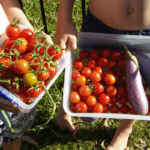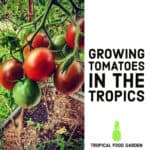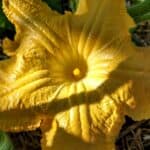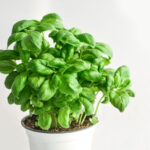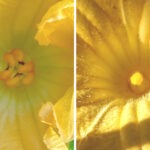This post may contain affiliate links.
The wet season of 2021 was our first wet season at home, in the tropics for 9 years. As such, it was hugely interesting to see exactly which food plants would survive the low light, intense heat, humidity, and torrential rain of the tropical summer. Not just survive, I wanted to see which vegetables, herbs, and fruits would feed my family through December, January, February, and March, thrive, and do well. I’m not one to follow standard advice, I have to see and test for myself, my background in biological science makes me curious. These are our findings, now, in 2025. What could we grow, and eat, through the tropical wet season, or summer months, now tested through more wet seasons.

I’m writing this post in January. The wet season is likely to get worse before it gets better. This post is intended to be running notes and over time, maybe years will form a thorough guide to foods that survive and produce in the wet season.

Garden Plants Providing Food in The Wet Season

The following plants are providing us with food through the wet summer months. More detail further down the page.
- Beans, see varieties below
- Peppers. Chilli peppers and sweet peppers, every type of pepper have done well through summer wet season and monsoon rains. Fruit flies can be a problem. If you see fruit going soft, remove it and dispose of it, break the reproductive cycle of the fruit fly larvae.
- Pumpkins and spaghetti squash. The pumpkins grew like crazy during the wet season and there were abundant pumpkins.
- Kale was OK at the start of the wet, but by the end most of it was rotted or eaten by bugs.
- Aubergines (eggplants). Every variety of eggplant we’ve tried can produce well through the wet. Eggplant is a summer crop for us but we have some problems with nematodes in the soil killing plants in this family.
- Herbs. None of my herbs have died due to wet season conditions, which honestly, is a surprise. Some are flourishing. Thyme is tricky, being a Mediterranean herb it didn’t like intense heat in October and November and died before the wet. I have more in the ground in a sheltered spot to test again. Basils seem to like summer and the wet. Cuban oregano grows like crazy through the wet summer, as does lemongrass. The garlic chices are thriving and mint also prefers the summer months.
- Asian Greens, Water spinach is looking super happy, longevity spinach is thriving.
- Tomatoes. I’m determined to grow wet-season tomatoes. Some are in open beds, taking the full brunt of the weather, others I’m babying along under cover, more below.
- Fruit. We have picked lemons, jackfruit, passionfruit, papayas, sapote, and pineapples during the wet. The grapefruit tree and lemon tree are covered in unripe fruit and survive the monsoon just fine. The fruit should be ripe in mid-summer onwards, we usually have 1 or 2 lemons by the start of February and we’ll be picking them for many months. Papayas produce a huge amount of fruit during the hot months and because they can be eaten ripe or unripe, this is a good food to grow to save you money on food bills.
- Coconuts, the coconut trees were laden with ripe coconuts and they were falling through the summer months.
- Corn, allegedly, grows in a tropical summer and/or wet season, we haven’t tested this yet.
- Loofah vines (Loofahs can be eaten like squash when young) are a wet-season vegetable we’re testing right now.
- I’ve read elsewhere that cucumbers can do well in the wet, we have some in the ground. I can tell you that they didn’t enjoy the extreme temperatures of late October into November. 2025 update – we have plenty of cucumbers in early February but the pest pressure is pretty intense. I have to check for beetles daily and squash them. We never use insecticides on our food. I gave the young cucumber plants shade on sunny days, they don’t like intense heat and strong sun.
- Tropical spinach (Brazil, Ceylon, Okinawa, longevity spinach etc) usually grows like crazy in the wet and hot. Bug damage can be an issue.
- Sweet potatoes enjoy heat and wet. To grow big tubers they need plenty of sun. All sorts of creatures, including rats, like to eat your sweet potato tubers so you may need to protect them. Sweet potato leaves are also edible.
- Cassava and taro are good tropical carbs for the summer or wet season.
From the above list you can see that you could, easily, be self-sufficient in home-grown food even in the tropical summer or wet season, particularly if you have some fruit and veg frozen, dried, or preserved from the cooler months. If you grow pigeon peas (lentils) or beans to dry, plus some chickens or other poultry, you should have plenty of protein.
I’ll also talk below about garden food crops which stopped producing, or died back during the wet season.
Seeds You Can Sew in The Wet Season
If you start looking at online seed companies, and dive into the sewing instructions, you’ll find that many fruits and vegetables can be sewn year round in tropical climates. However, take these instructions with a pinch of salt, they’re not always going to grow in your particular micro-climate.
Towards the end of the wet season, going into autumn, is a great time to sew cool weather plants like brassicas.
Plants That Died During The Wet
My curly kale and broccoli plants hated being soaked. The black kale lasted longer, but by the end of the wet it was sick and useless. Likewise, radishes, over-blown and left to go to seed, rotted in the ground.
Crops such as most brassicas and snow peas are winter crops, they’ll most likely be very unhappy in wet tropical summer heat.
Courgettes (zucchini) didn’t like the wet season at all, nor the high temperatures just before the wet. Powdery mildew and squash beetles are an issue. However, in late November, in a cooler few weeks, they looked healthy and started producing again.
The Best Beans in The Wet Season

For me, the dwarf red snake beans win hands-down over regular snake beans. The long, green snake beans became over-grown, their trellis fell down because the ground was waterlogged, and they only produced intermittently.
Admittedly, one bean is enough for a serving of beans, but we didn’t have as many as we did dwarf red beans.
The French beans and purple podded beans didn’t make it through the wet but produced prolifically in November and up to Christmas.
I have dwarf red snake beans in pots and in open garden beds, both have done well. The trick is to harvest every day when they are absolutely perfect for eating. You can store them, cut end down, in a glass of water in the fridge until you’re ready to use them.
If you do miss one it will quickly, within a day or so, become over-blown and not good to eat. Leave it to go to seed and push those seeds back into the ground. You will have a never-ending supply of beans.
I don’t think we’ve ever had a month without beans doing it this way. If a plant dies, and it will just cut it off at ground level. Leave those roots in the soil to rot and enrich the soil with nitrogen. I throw some worm juice or well rotted manure at them now and again if they look like they need a boost.
Cucumbers in the Wet Season
I’ve found cucumbers difficult to grow at most times of year other that late winter/early spring. I’ve managed to keep cucumber plants alive through the wet season, they’ve produced very few flowers, no female flowers. So cucumbers for me are a wet season fail, along with zucchini, squash and everything else in this family except pumpkins and spaghetti squash.

It is thought that pollination fails in high temperatures and humidity for zucchini and summer squash. I’ve noticed this, and that the plants produce fewer female flowers when it’s very hot. As the cloud builds up and temperatures actually drop towards the wet, they’ve produced again and recovered from powdery mildew. So don’t always pull them out if you don’t have to.
Tomatoes in the Wet Season
I’ve managed to grow tomatoes in the wet, very few and they didn’t look good. The Roma tomatoes in the photo above were picked right in the middle of the tropical summer. They didn’t taste great and they weren’t pretty. We managed to get a few cherry tomatoes too, but again, they weren’t great.
I kept these tomatoes, chopped, in the freezer to use for making tomato sauce.
Once the worst of the wet was over they came back to normal production, the same sort of levels of fruit that we saw in spring, before it got too hot and dry. Our tomato plants all survived the tropical summer and were relatively pest and disease-free. Some grew prolific new green growth during the wet.
I did a lot of pruning, cutting back and starting new plants from cuttings, undercover, The wet season seems to be a great time for leafy growth, but not fruiting vegetables, other than peppers and aubergines (egg plants). You have to keep a close eye out for fruit fly and keep enriching and fertilizing the soil. Torrential rain leaches out nutrients fast.
If your tomatoes are hit by fruit fly, be sure to put the damaged fruit in the bin, this breaks the life cycle as the larvae will be inside the tomato. They normally emerge once the fruit rots or falls.
Shield bugs will bite your tomatoes too. Netting them with plastic bags doesn’t help much as they can bite through the plastic mesh if it touches the tomato. Sticky fly traps indiscriminately kill wildlife, including small frogs and geckos, so they’re not a good idea either.
Look out for blossom end rot in tomatoes, add calcium to the soil at the first signs.
Wet Season Gardening Wrap-Up
As with all content on this website, I update posts as I discover more. These are my gardening notes and findings on this, my 8th website. I’m a professional blogger in another field. I’ll be back with more on wet-season gardening soon. It’s wet season right now and I’m excited to see what food we can grow in a tropical summer.
